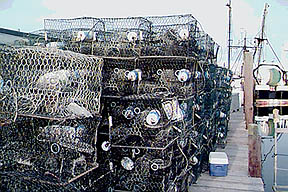| Pots are constructed
either of wooden slats or, more commonly, coated wire mesh. They are set
on the bottom individually or in strings and harvest various species of
shellfish and finfish. In New Jersey's waters they are used to trap lobster,
blue crabs, whelks (often called conch) and sea bass.
Pot fishing can be done in shallow estuaries,
in inshore ocean waters and in deeper water offshore. The traps range in
size from the two or three foot long crab pots to the very large, deep
water traps used in the Bering Sea tanner and king crab fisheries. These
can be ten feet square. The smaller pots are hauled from the bottom by
hand while the larger traps require hydrtaulic haulers.
The pots are usually baited but often, particularly
on flat, sandy bottoms, it is thought that the quarry enters traps as much
for the shelter they offer as for food.
Traps are a form of semi-permanent staked net
designed to intercept and hold fish during their annual or daily migrations
along the coast. While they used to be fairly common on the New Jersey
coast just outside the breakers, there are no ocean fish traps in use here
today.
[ a
link to Seacoast Information Services, Inc.'s Aquatic Network in-depth
series by Dr. Michael Pierik on his experiences with fish traps on
Cape Cod in 1945-46] a
link to Seacoast Information Services, Inc.'s Aquatic Network in-depth
series by Dr. Michael Pierik on his experiences with fish traps on
Cape Cod in 1945-46] |




